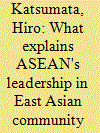| Srl | Item |
| 1 |
ID:
176055


|
|
|
|
|
| Summary/Abstract |
Despite the dangers Donald Trump posed to constitutional rule and political norms, he may turn out to have been good for democracy in America.
|
|
|
|
|
|
|
|
|
|
|
|
|
|
|
|
| 2 |
ID:
132375


|
|
|
|
|
| Publication |
2014.
|
| Summary/Abstract |
India's Ganges River has suffered from massive amounts of pollution for decades, and despite numerous attempts, the Indian government has failed to clean up this historic water resource. This governance failure prompted the growth of civil society groups whose stated purposes included the mitigation of Ganges pollution and the empowerment of community-based solutions. These types of groups, however, have not found sustained success in alleviating Ganges pollution, despite their compatibility with the constitutional decentralization of Indian water policy. A case study of one of these civil society organizations, the Sankat Mochan Foundation (SMF), serves as a first step in assessing the efficacy of this community-based approach to Ganges pollution mitigation. From a broader perspective, the story of the SMF speaks to the difficulties inherent in environmental policy decentralization and to the struggles of norm creation and diffusion across societies. Indeed, this case is particularly instructive, as it exposes potential vulnerabilities in the literature regarding the role of civil society groups as norm entrepreneurs. Rather than allow for the democratization of water policy, as called for by the Indian constitution, the case of the SMF suggests the Indian government has entrenched centralization to the point of diffusing civil society opposition and ultimately compromising the overall impact of its resistance.
|
|
|
|
|
|
|
|
|
|
|
|
|
|
|
|
| 3 |
ID:
131064


|
|
|
|
|
| Publication |
2014.
|
| Summary/Abstract |
Conventional wisdom holds that the Association of Southeast Asian Nations (ASEAN) has been able to lead community building in East Asia by default, against the background of Sino-Japanese rivalries. The present study maintains that this line of argument is insufficient, and offers a complementary account, centered on the statement that ASEAN has actively constructed a social environment which defines itself as the legitimate leader of East Asian community building. More specifically, the leadership of ASEAN can be explained in terms of three parallel developments since the early 1990s that are associated with the Asia-Pacific framework of the ASEAN Regional Forum (ARF): the Southeast Asian association has been able to lead community building in East Asia becauseissue_image_87_2_Katsumata (1) it has advanced the vision of an "East Asian community" by drawing on its cooperative security norm embodied in the ARF; (2) through their participation in the ARF process, the Northeast Asian powers have come to recognize the value of ASEAN's cooperative security norm, and thus to share with the Southeast Asian nations their vision of an East Asian community; and (3) the sharing of a community-building vision by all the East Asian countries has constituted a structure that makes it costly for the Northeast Asian powers to challenge the Southeast Asian association.
|
|
|
|
|
|
|
|
|
|
|
|
|
|
|
|